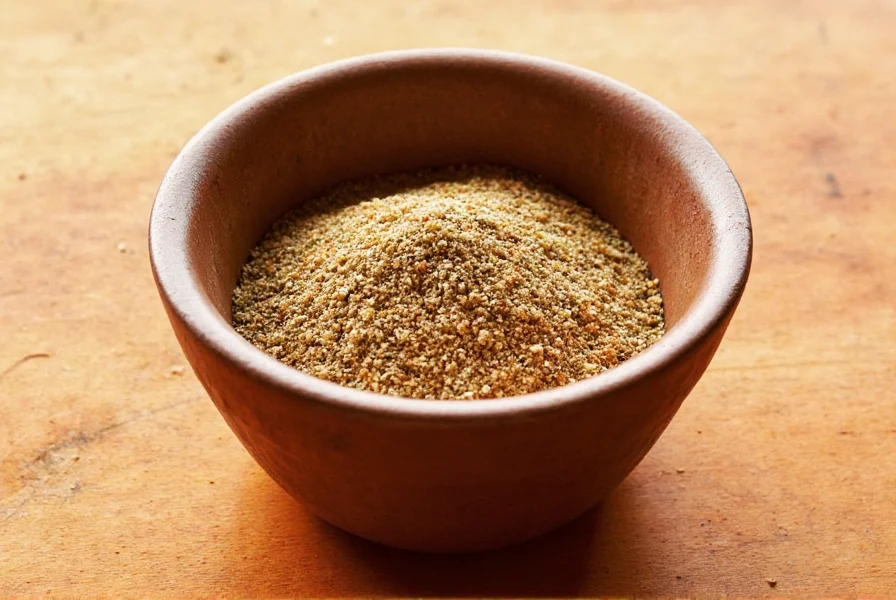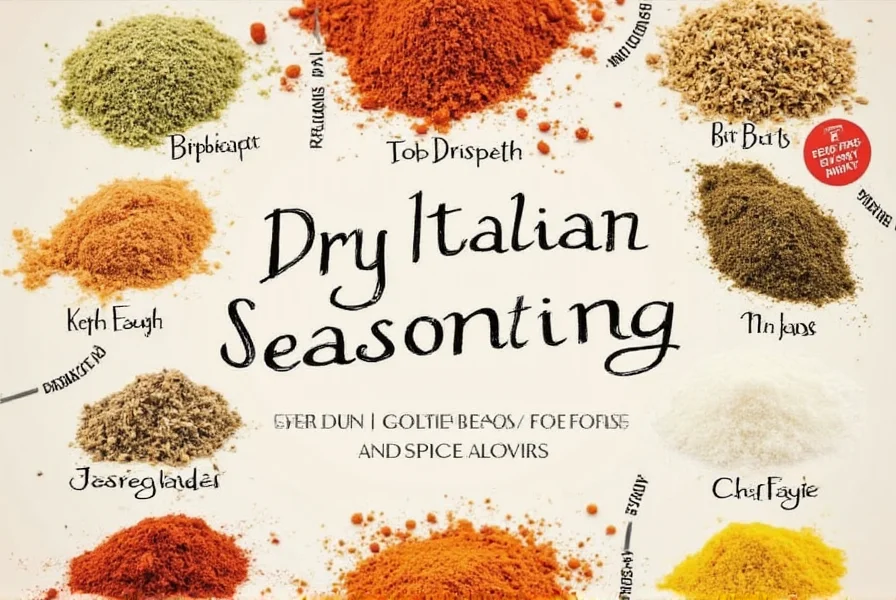Table of Contents
Introduction to Dry Italian Seasoning
Dry Italian seasoning is a pre-mixed blend of dried herbs commonly used in Italian cuisine to add flavor to dishes like pasta sauces, roasted vegetables, and grilled meats. It typically includes oregano, basil, thyme, rosemary, and marjoram, and sometimes garlic or onion powder. This versatile seasoning is a staple in many kitchens, offering a convenient way to enhance meals with authentic Italian flavors.
What Is Dry Italian Seasoning?
Dry Italian seasoning is a blend of dried herbs designed to mimic the flavors of traditional Italian cooking. The core ingredients usually consist of oregano, basil, thyme, rosemary, and marjoram. Some blends may also include garlic powder, onion powder, or other spices for added depth.
Unlike fresh herbs, which provide bright, vibrant flavors, dry Italian seasoning offers a more concentrated and shelf-stable option. It's perfect for everyday cooking when you want quick flavor without the hassle of chopping fresh herbs.

How to Use It
Dry Italian seasoning is incredibly versatile. Here are specific culinary applications:
- Pasta Sauces: Add 1 tablespoon to 2 cups of tomato sauce for classic spaghetti sauce. Simmer for 15 minutes to develop flavors.
- Roasted Vegetables: Toss 2 cups of chopped vegetables (zucchini, bell peppers, eggplant) with 1 tablespoon olive oil and 1 teaspoon dry Italian seasoning. Roast at 400°F (200°C) for 20-25 minutes.
- Grilled Chicken: Rub 1 teaspoon of dry Italian seasoning on chicken breasts before grilling for aromatic, flavorful results.
- Pizza: Sprinkle directly on pizza dough before adding toppings for enhanced crust flavor.
- Salad Dressing: Mix 1 teaspoon dry Italian seasoning with 2 tablespoons olive oil and 1 tablespoon vinegar for quick Italian dressing.
Pro Tip: Add dry seasoning early in cooking for maximum flavor development. For fresh herb brightness, combine with fresh basil or oregano at the end of cooking.
Flavor Profile and Key Ingredients
The flavor of dry Italian seasoning is a harmonious blend of aromatic, earthy, and slightly sweet notes. Each herb contributes unique characteristics:
- Oregano: Strong, pungent, and slightly bitter — the backbone of the blend.
- Basil: Sweet, fragrant, and slightly peppery — adds freshness.
- Thyme: Subtle, lemony, and floral — provides depth.
- Rosemary: Pine-like, woody aroma — enhances savory dishes.
- Marjoram: Milder, sweeter than oregano — balances the blend.
When garlic or onion powder is included, they add umami and savory notes, making the seasoning more complex and satisfying.
Practical Tips for Using Dry Italian Seasoning
Here are expert tips to maximize your dry Italian seasoning:
- Make Your Own Blend: Create a custom blend at home: 2 tbsp dried oregano, 1 tbsp dried basil, 1 tbsp dried thyme, 1 tbsp dried rosemary, 1 tbsp dried marjoram, 1 tsp garlic powder (optional), 1 tsp onion powder (optional). Store in an airtight container.
- Start Small: Since the seasoning is concentrated, begin with 1/2 teaspoon per serving and adjust to taste.
- Combine with Fresh Herbs: For dishes where freshness matters, add dry seasoning early and fresh herbs at the end.
- Use in Baking: Add a pinch to bread dough or pizza crust for extra flavor.
- Store Properly: Keep in a cool, dark place in an airtight container to preserve freshness for up to 2 years.
Try using dry Italian seasoning in non-traditional ways: sprinkle on popcorn, mix into mayonnaise for sandwich spreads, or add to scrambled eggs for savory breakfasts.

Buying Guide: Choosing the Best Dry Italian Seasoning
With so many options on the market, choosing the right dry Italian seasoning requires attention to quality and purpose. Here's what to consider:
Key Features to Look For
- Quality of Herbs: High-quality blends use whole dried herbs rather than powdered ones for better flavor retention.
- Ingredient List: Look for natural ingredients and avoid artificial additives, fillers, or anti-caking agents.
- Brand Reputation: Choose established brands known for quality and consistency in food products.
- Usage Scenarios: Consider how you'll use the seasoning — some blends are ideal for baking, while others are better for savory dishes.
| Product Name | Features | Best For |
|---|---|---|
| McCormick Dry Italian Seasoning | Classic blend with oregano, basil, thyme, rosemary, and marjoram; widely available | Pasta sauces, marinades, and everyday cooking |
| Penzeys Italian Seasoning | Handcrafted blend with premium herbs; rich, aromatic flavor profile | Special occasions, gourmet dishes, and culinary experimentation |
| Southern Seasons Italian Seasoning | Includes garlic and onion powder for added depth; robust flavor | Meats, vegetables, and dressings where extra umami is desired |
| Spice Islands Italian Seasoning | Balanced blend with no added fillers; consistent flavor | General cooking and versatile applications |
Each product has unique strengths. McCormick offers reliable consistency for everyday use. Penzeys provides premium quality for special dishes. Southern Seasons adds savory depth with garlic and onion powder. Spice Islands delivers balanced flavor without additives.

Frequently Asked Questions
Q: Can I use dry Italian seasoning in place of fresh herbs?
A: Dry Italian seasoning is a good substitute when fresh herbs are unavailable, but it won't provide the same bright, fresh flavor. For best results, use it in combination with fresh herbs when possible — add dry seasoning early in cooking and fresh herbs at the end.
Q: How long does dry Italian seasoning last?
A: When stored properly in an airtight container away from heat and light, dry Italian seasoning can last up to 2-3 years. However, the flavor may start to diminish after 6-12 months, so check aroma and taste periodically.
Q: What's the difference between Italian seasoning and Italian herbs?
A: Italian seasoning is a specific pre-mixed blend of dried herbs designed to mimic traditional Italian flavors. Italian herbs typically refers to individual dried herbs like oregano or basil. Italian seasoning is a convenient all-in-one solution, while individual herbs allow for more precise flavor control.
Q: Can I make dry Italian seasoning without garlic or onion powder?
A: Yes, many traditional Italian seasoning blends omit garlic and onion powder. The core ingredients are oregano, basil, thyme, rosemary, and marjoram. You can customize your blend by adding or omitting these optional ingredients based on your preferences.
Conclusion
Dry Italian seasoning is a versatile kitchen staple that brings authentic Italian flavors to countless dishes. By understanding its composition, proper usage, and how to select quality products, you can elevate your cooking with minimal effort. Whether you're making pasta sauces, roasted vegetables, or grilled meats, this seasoning offers a convenient way to add depth and complexity to your meals.
Remember to store it properly to maintain freshness, and don't hesitate to experiment with new applications. From savory breakfasts to gourmet dinners, dry Italian seasoning is a simple ingredient that can transform ordinary dishes into extraordinary culinary experiences.











 浙公网安备
33010002000092号
浙公网安备
33010002000092号 浙B2-20120091-4
浙B2-20120091-4